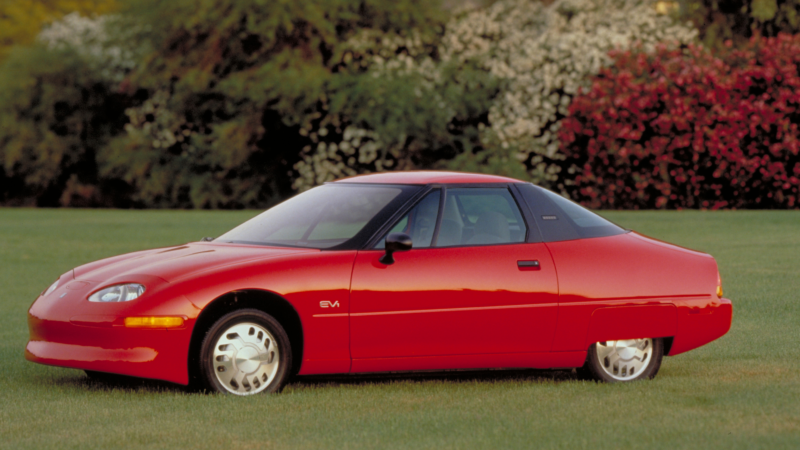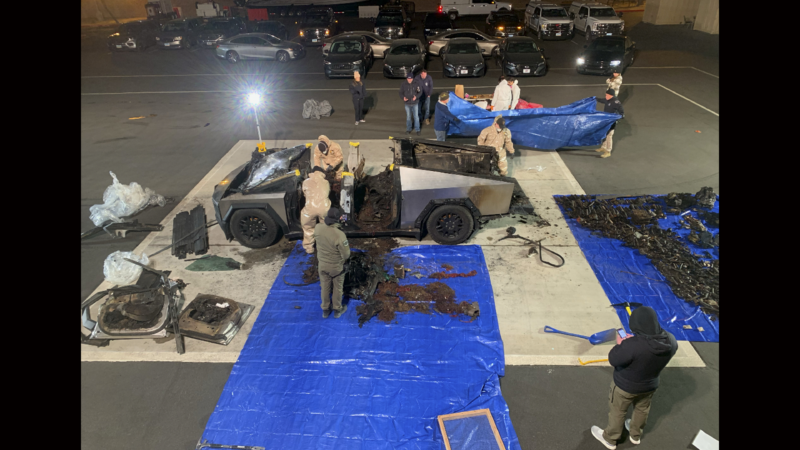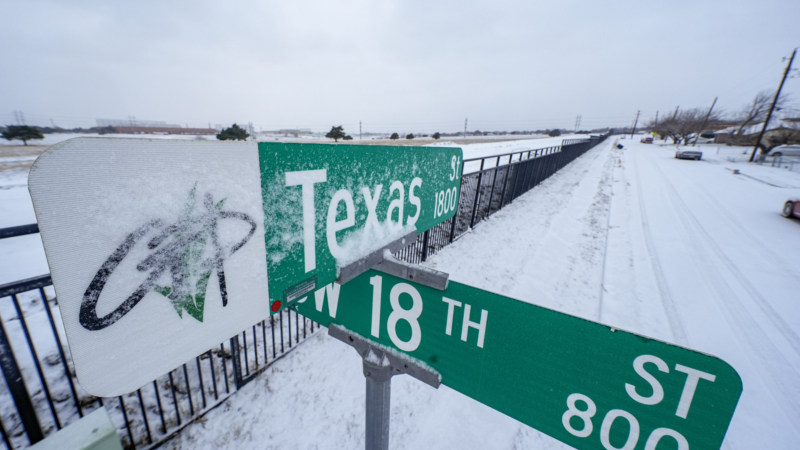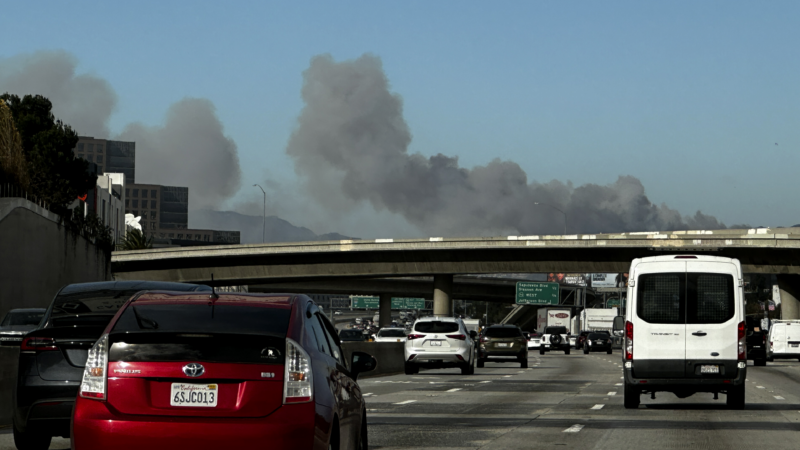This little electric car made history. 25 years ago, GM stopped making it
It was the most reliable car he had ever driven — that’s how Kris Trexler remembered his General Motors EV1.
“It was just a car that I took home, plugged in at night, got up the next morning — it was like having a gasoline station in the garage,” he told NPR Member station Michigan Public in 2010.
Trexler was one of the hundreds of people who got to drive an EV1 — the first modern, mass-produced electric vehicle from a major automaker. The little two-door car looked like a cross between a flying saucer and a computer mouse, and it pioneered technology you can still find in today’s EVs.
GM built just over 1,000 EV1s before ending production in 1999, spawning a community of passionate super fans eager to join the EV revolution. But the EV1 was controversial, and short-lived. It was on the road for less than a decade. Many Americans never knew the EV1 existed — and the fight to keep it alive ended with GM crushing nearly all the cars into scrap.
“When it all happened, we just stood there and said, ‘What are you guys doing?’ ” filmmaker and EV advocate Chris Paine told NPR in a 2006 interview about his documentary Who Killed the Electric Car? “The sight of seeing them destroyed before most people ever got to experience them was really quite a shocking moment for us.”
The EV1’s origins
The story of the EV1 began in 1990, when California passed sweeping regulations aimed at curbing the state’s air pollution. The plan mandated automakers build zero-emission vehicles.
“It’s a very radical strategy, but it’s one that looks well into the next century,” California Air Resources Board member Brian Bilbray said at the time. “And it’s really going to set the standard for air-quality strategies, not in just this state or this nation, but in the world.”
Under pressure, automakers researched electric vehicles, hybrids and even hydrogen fuel cells to comply with the mandate. In 1992, reporter Paul Eisenstein was assigned by NPR to check out the early results, traveling to Arizona to test drive a GM prototype called the Impact.
“As you turn the key, nothing seems to be happening — until you stomp on the Impact’s accelerator,” Eisenstein reported. “Then with a sudden lurch and an eerie whine, the Impact bursts to life, the speedometer ticking off five, 15, 30, 45 miles an hour.”
This is the car that by 1996 hit the market as the EV1. It had zippy acceleration, aerodynamic bodywork that partially covered the rear tires, and an innovative braking system that helped recharge the battery.
“Regenerative braking works by using the motors — the drive motors — in reverse, and they act as generators,” GM engineer Larry Oswald said. “So when you apply the brake pedal, essentially what you’re doing is generating electricity and putting it back into the battery and storing it for the next acceleration.”
The car’s battery could take you about 70 miles on a full charge. Battery technology improved over the years, increasing the EV1’s range to about 100 miles. But the EV1 gave rise to a new consumer concern: “range anxiety.”
“The fear of being stranded; running out of power,” Consumer Reports researcher Ron Conlin told NPR in 1997. “The anxiety of the consumer is reflected in our studies.”
The EV1 was only available in a few states. And it was expensive: The suggested retail price was $35,000 (more than $70,000 in today’s money) but it never actually was for sale — it was only available for lease.
“The car’s being marketed to an upscale consumer — very educated, very affluent, as potentially a third vehicle in the household,” Conlin said.
Only about 800 drivers leased an EV1, according to an Associated Press article from 2005. However, reports indicated thousands more people put their name on a wait list. GM spokesperson Dave Barthmuss told NPR that the company followed up with those people, and found “less than 50 customers” on the wait list were willing to lease a vehicle.
Many who did get the chance to lease an EV1 grew to love the way the car — with its plug-in charging and appliance-like charm — made them feel “like we were in the 21st century,” said documentarian Chris Paine.
A little car with a big legacy
GM had spent more than $1 billion on EV development. But over time, California weakened the mandate to build zero-emission vehicles. The EV1 became an unnecessary cost.
The cars’ three-year lease agreements expired in the early 2000s, but GM canceled the program and took its EV1s back. In 2005, NPR reporter Luke Burbank visited a GM facility in Southern California storing dozens of repossessed EV1s. The car’s supporters held vigil outside.
“We call that EV1 death row,” said Chelsea Sexton, a former GM employee who worked on the EV1 program and was critical of the company’s move to stop making electric vehicles.
“It absolutely breaks my heart,” Sexton told NPR. “I helped put these cars on the road in the first place, and now they’re taking them away from me and from all the other drivers that had them at one point.”

GM loaded the EV1s onto semi trucks, hauled them to Mesa, Ariz., and crushed them. Photos showed flattened EV1s stacked on top of each other. GM said the cars were destroyed because a lack of replacement parts made the EV1 unsafe.
“There are 2,000 unique parts to this vehicle,” Barthmuss said. “Some of them are computer control modules that control the braking on the vehicle. If that part fails, there are some serious safety concerns.”
The EV1 was ahead of its time
Twenty-five years after EV1 production ended, every major automaker is building EVs — including GM. In October the company said it’s on track to build about 200,000 EVs this year. GM set a goal to phase out gas-powered vehicles by 2035.
As for the EV1, some of the little cars escaped the crusher. In 2010, former EV1 driver Kris Trexler visited the very car he once plugged in to charge each night. It was in a new home: the Petersen Automotive Museum in Los Angeles — one of only 40 EV1s still intact, according to the museum.
“Wow, this brings back some serious memories,” Trexler said. “This is just amazing to see this car again.”
Photos: Thousands in Los Angeles evacuate as wind-fueled Palisades Fire quickly worsens
More than 30,000 people in Los Angeles County have been ordered to evacuate as the Palisades Fire blazed through the Pacific Palisades community, fueled by intense Santa Ana winds.
Man who exploded Cybertruck in Las Vegas used ChatGPT in planning, police say
The highly decorated soldier who exploded a Tesla Cybertruck outside the Trump hotel in Las Vegas used generative AI including ChatGPT to help plan the attack, Las Vegas police said Tuesday.
Wild weather brings snow to the South and Santa Ana winds to the West
As the South prepped for snow and more cold starting Wednesday, residents in Southern California faced off with hurricane-strength winds.
What to know about Trump and his keen interest in Greenland
President-elect Donald Trump has said multiple times that the U.S. should buy Greenland, an autonomous territory of Denmark. The sparsely populated island is geopolitically important and mineral-rich.
There’s great TV coming in January, from ‘Severance’ Season 2 to a Jerry Springer doc
There is a lot of TV on deck in the new year – including multiple medical dramas, a violent Netflix drama about Utah settlers in the 1850s, plus, cop shows, Westerns and documentaries.
Life-threatening windstorm triggers wildfire in Southern California
Southern California hasn't seen significant rainfall since last April, and a pileup of dry fuel in combination with the winds has the region on edge. A mandatory evacuation order was issued for the Palisades.







